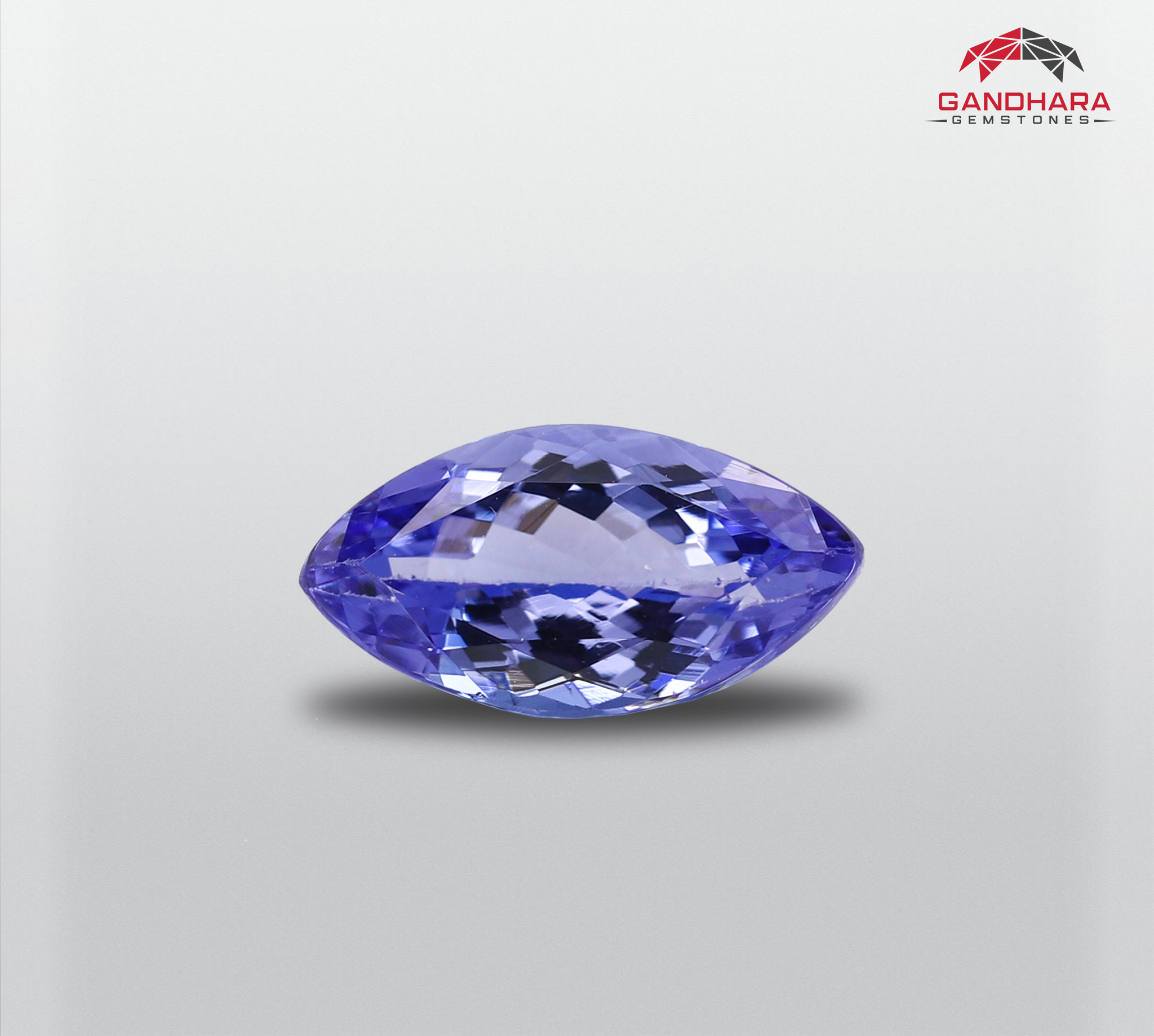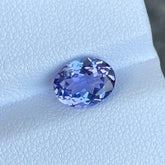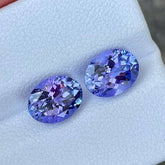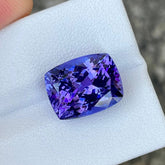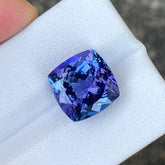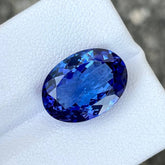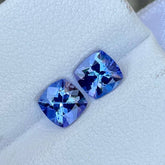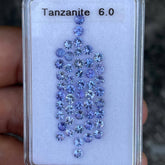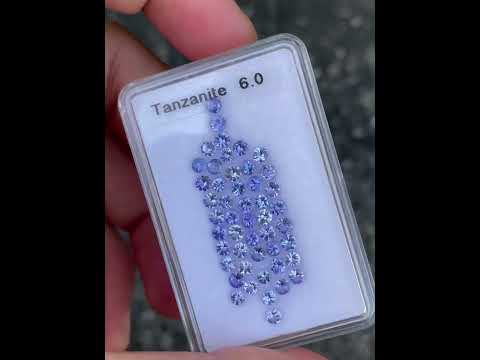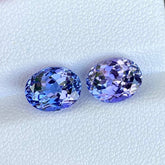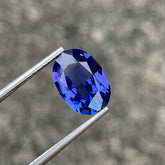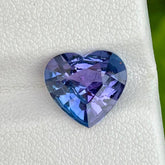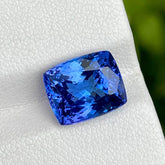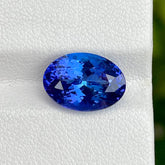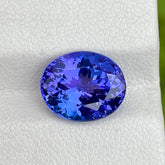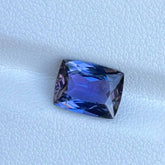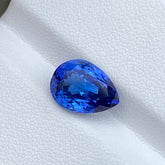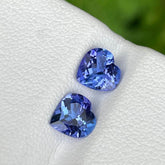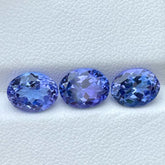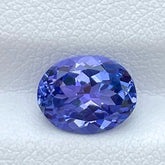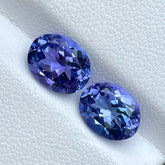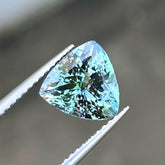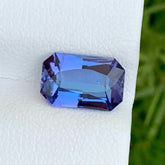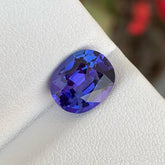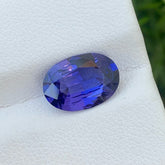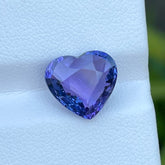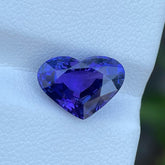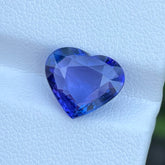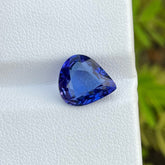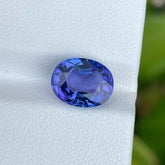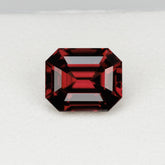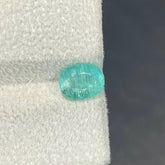Filter
54 results
30
- 10
- 15
- 20
- 25
- 30
- 50
Date, new to old
- Featured
- Best selling
- Alphabetically, A-Z
- Alphabetically, Z-A
- Price, low to high
- Price, high to low
- Date, old to new
- Date, new to old
Sort
Sort by:
- Featured
- Best selling
- Alphabetically, A-Z
- Alphabetically, Z-A
- Price, low to high
- Price, high to low
- Date, old to new
- Date, new to old
-
2.18 carats Blue Tanzanite Stone Oval Cut Natural Tanzanian Gemstone - Blue
Crafted from the rarest and most exceptional quality Tanzanite, this 2.18 carats Blue Tanzanite Stone is a breathtaking masterpiece of nature's finest artistry. Its oval cut design accentuates the inherent beauty of this natural Tanzanian gemstone, revealing a mesmerizing spectrum of deep blues and...- $250.00
- $250.00
- Unit price
- / per
-
Blue
-
4.24 carats Blue Tanzanite Stone Pair Oval Shaped Tanzanian Gemstone - purplish_blue
This exquisite pair of blue tanzanite gemstones weighs a total of 4.24 carats and showcases a captivating deep blue hue, accented with undertones of violet that reveal their unique allure. Each stone is expertly cut into a classic oval shape, enhancing the natural brilliance...- $525.00
$585.00- $525.00
- Unit price
- / per
-
purplish_blue
-
9.75 carats Blue Tanzanite Stone Custom Precision Cut Tanzanian Gemstone - purplish_blue
Crafted from the rarest and most exceptional quality Tanzanite, this 9.75 carats Blue Tanzanite Stone is a breathtaking masterpiece of nature's finest artistry. Its custom precision cut design accentuates the inherent beauty of this natural Tanzanian gemstone, revealing a mesmerizing spectrum of deep blues...-
purplish_blue
-
-
8.86 carats Blue Tanzanite Stone Cushion Cut Natural Tanzanian Gemstone - purplish_blue
Crafted from the rarest and most exceptional quality Tanzanite, this 8.86 carats Blue Tanzanite Stone is a breathtaking masterpiece of nature's finest artistry. Its oval cut design accentuates the inherent beauty of this natural Tanzanian gemstone, revealing a mesmerizing spectrum of deep blues and...-
purplish_blue
-
-
8.46 carats Blue Tanzanite Stone Oval Cut Natural Tanzanian Gemstone - Blue
Crafted from the rarest and most exceptional quality Tanzanite, this 8.46 carats Blue Tanzanite Stone is a breathtaking masterpiece of nature's finest artistry. Its oval cut design accentuates the inherent beauty of this natural Tanzanian gemstone, revealing a mesmerizing spectrum of deep blues and...-
Blue
-
-
1.85 carats Blue Tanzanite Stone Pair Cushion Cut Tanzanian Gemstone - purplish_blue
This exquisite pair of blue tanzanite gemstones, with a combined weight of 1.85 carats, is a true testament to the mesmerizing beauty of nature’s rarest treasures. Each stone features a precision cushion cut, enhancing its brilliance and allowing light to dance across its facets...- $350.00
$390.00- $350.00
- Unit price
- / per
-
purplish_blue
-
6 carats Blue Tanzanite Lot 48 Piece 3mm Round Cut Tanzanian Gemstones - purplish_blue
This is a stunning lot of 48 round cut Tanzanite gemstones, each measuring approximately 3mm in diameter with a total carat weight of 6 carats. Originating from the rich gem deposits of Tanzania, these stones exhibit the captivating blue-violet hue that Tanzanite is cherished...- $425.00
$475.00- $425.00
- Unit price
- / per
-
purplish_blue
-
5.33 carats Blue Tanzanite Stone Pair Oval Shaped Tanzanian Gemstone - purplish_blue
This exquisite pair of blue tanzanite gemstones weighs a total of 5.33 carats and showcases a captivating deep blue hue, accented with undertones of violet that reveal their unique allure. Each stone is expertly cut into a classic oval shape, enhancing the natural brilliance...- $705.00
$785.00- $705.00
- Unit price
- / per
-
purplish_blue
-
2.82 carats Blue Tanzanite Stone Oval Cut Natural Tanzanian Gemstone - Blue
Crafted from the rarest and most exceptional quality Tanzanite, this 2.82 carats Blue Tanzanite Stone is a breathtaking masterpiece of nature's finest artistry. Its oval cut design accentuates the inherent beauty of this natural Tanzanian gemstone, revealing a mesmerizing spectrum of deep blues and...- $550.00
- $550.00
- Unit price
- / per
-
Blue
-
3.05 carats Heart Shaped Blue Tanzanite Stone Natural Tanzanian Gemstone - Blue
The 3.05-carat heart-shaped blue tanzanite gemstone, sourced from the mineral-rich lands of Tanzania, is a remarkable example of nature's artistry. This exquisite gem captivates with its intense, deep blue hue, occasionally exhibiting flashes of violet that add to its enchanting allure. Cut into a...- $350.00
- $350.00
- Unit price
- / per
-
Blue
-
6.25 carats AAA+ Grade Blue Tanzanite Stone Natural Tanzanian Gemstone - Blue
This magnificent 6.25 carats AAA+ Grade Blue Tanzanite Stone embodies the epitome of elegance and luxury. Originating from the rich mines of Tanzania, this natural gemstone exudes a captivating allure with its deep blue hues, reminiscent of the pristine waters of the Indian Ocean....- $1,200.00
- $1,200.00
- Unit price
- / per
-
Blue
-
5.90 carats AAA+ Grade Tanzanite Stone Oval Cut Natural Tanzanian Gemstone - Blue
Crafted from the rarest and most exceptional quality Tanzanite, this 5.90 carats AAA+ Grade Tanzanite Stone is a breathtaking masterpiece of nature's finest artistry. Its oval cut design accentuates the inherent beauty of this natural Tanzanian gemstone, revealing a mesmerizing spectrum of deep blues...- $1,200.00
- $1,200.00
- Unit price
- / per
-
Blue
-
4.70 carats AAA+ Grade Tanzanite Stone Oval Cut Natural Tanzanian Gemstone - Blue
This exquisite 4.70 carats AAA+ Grade Tanzanite Stone boasts unparalleled beauty with its radiant allure. Cut into an elegant oval shape, this natural Tanzanian gemstone showcases a mesmerizing blend of deep blues and violet hues, exuding a captivating brilliance. Renowned for its rarity and...- $950.00
- $950.00
- Unit price
- / per
-
Blue
-
2.80 carats Blue Tanzanite Stone Mix Cushion Cut Natural Tanzanian Gemstone - Blue
Behold the captivating allure of a 2.80-carat Blue Tanzanite Stone, a true testament to the mesmerizing beauty of natural gemstones. Meticulously crafted in a charming Cushion Cut, this Tanzanian gemstone unveils a spectrum of enchanting blue hues that dance with the play of light....- $220.00
- $220.00
- Unit price
- / per
-
Blue
-
Pear Shaped Blue Tanzanite Stone 4.50 carats Natural Tanzania Gemstone - Blue
A striking and rare gem, this natural Tanzanian Tanzanite stone boasts a captivating pear-shaped cut that enhances its natural beauty. Weighing an impressive 4.50 carats, this gemstone showcases a rich and enchanting blue hue that ranges from deep royal blues to vibrant violet tones....- $765.00
- $765.00
- Unit price
- / per
-
Blue
-
Heart Shaped Blue Tanzanite Stone Pair 2.35 carats Natural Tanzanian Gemstone - Blue
Introducing an exquisite pair of Heart Shaped Blue Tanzanite Stones, each weighing 2.35 carats, and sourced directly from the rich Tanzanian mines. These natural Tanzanite gemstones are an embodiment of elegance and grace. Product Information: Gemstone Type Heart Shaped Tanzanite Pair Weight 2.35...- $470.00
- $470.00
- Unit price
- / per
-
Blue
-
Precious Blue Tanzanite Stones 6.35 carats Oval Shaped Natural Tanzanian Gemstone - Blue
Discover the captivating allure of our exquisite 6.35 carat Oval Shaped Blue Tanzanite Stone, a true masterpiece of nature hailing from the heart of Tanzania. This lustrous gemstone boasts an enchanting blue hue that sparkles and radiates elegance from every angle. Product Information:...- $638.00
- $638.00
- Unit price
- / per
-
Blue
-
Prismatic Blue AA+ Grade Tanzanite 2.10 carats Fancy Oval Cut Natural Tanzanian Gemstone - Blue
The Blue AA+ Grade Tanzanite is a natural gemstone known for its exquisite blue-violet color. Tanzanite is a variety of the mineral zoisite and is highly valued for its rarity and unique coloration. Here is a detailed description of the 2.10 carat Fancy Oval...- $200.00
- $200.00
- Unit price
- / per
-
Blue
-
Opalescent Blue Tanzanite Stone Pair 4.25 carats Oval Shaped Natural Tanzanian Gemstone - Blue
Discover a captivating pair of natural Tanzanian gemstones with this exquisite Blue Tanzanite Stone Pair. Each stone boasts an impressive 4.25 carat weight and features an elegant oval shape that enhances their inherent beauty. Elevate your jewelry collection with these genuine Tanzanite gems, perfect...- $380.00
- $380.00
- Unit price
- / per
-
Blue
-
Fantastic Natural Loose Tanzanite Gemstone - LightBlue
Fantastic Natural Loose Tanzanite Gemstone, Available For Sale At Wholesale Price Natural High Quality 2.85 Carats SI Clarity Loose Tanzanite Stone From Tanzania. Product Information: Gemstone Type Fantastic Natural Loose Tanzanite Gemstone Weight 2.85 carats Dimensions 8.7 x 8.7 x 6.1 mm Clarity SI...- $490.00
- $490.00
- Unit price
- / per
-
LightBlue
-
Stunning Natural Blue Tanzanite Gemstone - Blue
Stunning Natural Blue Tanzanite Gemstone, available for sale at wholesale price natural high quality 3.00 Carats Loupe Clean Clarity Heated Tanzanite from Tanzania. Product Information: Gemstone Type Stunning Natural Blue Tanzanite Gemstone Weight 3.00 carats Dimensions 10.7 x 7.5 x 4.8 mm Clarity Loupe...- $620.00
- $620.00
- Unit price
- / per
-
Blue
-
Exceptional Natural Blue Tanzanite Gemstone - Blue
Exceptional Natural Blue Tanzanite Gemstone, available for sale at wholesale price natural high quality oval cushion shape 3.55 carats natural tanzanite from tanzania. Product Information: Gemstone Type Exceptional Natural Blue Tanzanite Gemstone Weight 3.55 carats Dimensions 10.7 x 8.9 x 5.5mm Cut Step Oval...- $700.00
$245.00- $700.00
- Unit price
- / per
-
Blue
-
Lusturious Natural Tanzanite Heart-shaped - Blue
Tanzanite stone, Available For Sale At Wholesale Price Natural High Quality 1.00 Carats Eye Clean Clarity Loose Tanzanite From Tanzania. Product Information: Gemstone Type Lusturious Natural Tanzanite Heart-shaped Weight 1.00 carats Dimensions 6.7 x 6.5 x 4 mm Clarity Eye Clean Cut Faceted...- $120.00
- $120.00
- Unit price
- / per
-
Blue
-
Exceptional Natural Blue Tanzanite Gemstone - Blue
Exceptional Natural Blue Tanzanite Gemstone, Available For Sale At Wholesale Price Natural High Quality 3.35 Carats Loupe Clean Clarity Loose Tanzanite Stone From Tanzania. Product Information: Gemstone Type Exceptional Natural Blue Tanzanite Gemstone Weight 3.35 carats Dimensions 9.2 x 7.9 x 5.9 mm Clarity...- $700.00
- $700.00
- Unit price
- / per
-
Blue
-
Exquisite Natural Blue Tanzanite Gemstone - Blue
Exquisite Natural Blue Tanzanite Gemstone, Available For Sale At Wholesale Price Natural High Quality 2.80 Carats Loupe Clean Clarity Loose Tanzanite Stone From Tanzania. Product Information: Gemstone Type Exquisite Natural Blue Tanzanite Gemstone Weight 2.80 carats Dimensions 11.8 x 8.3 x 4.2mm Clarity Loupe...- $500.00
- $500.00
- Unit price
- / per
-
Blue
-
Gorgeous Heart Shaped Loose Tanzanite - Blue
Gorgeous Heart Shaped Loose Tanzanite of 4.29 Carat from Tanzania has a wonderful cut in a Heart shape, incredible Blue color. Great brilliance. This gem is totally Eye Clean Clarity. Product Information: Gemstone Type Gorgeous Heart Shaped Loose Tanzanite Weight 4.29 carats Dimensions...- $620.00
- $620.00
- Unit price
- / per
-
Blue
-
Lovely AAA Quality Tanzanite Gemstone - Blue
Lovely AAA Quality Tanzanite Gemstone of 3.89 Carat from Tanzania has a wonderful cut in a heart shape, incredible blue color. Great brilliance. This gem is totally loupe clean Clarity. Product Information: Gemstone Type Lovely AAA Quality Tanzanite Gemstone Weight 3.89 carats Dimensions...- $665.00
- $665.00
- Unit price
- / per
-
Blue
-
AAA Quality Soft Blue Tanzanite Stone - Blue
AAA Quality Soft Blue Tanzanite Stone of 3.60 Carat from Tanzania has a wonderful cut in a Heart shape, incredible Blue color. Great brilliance. This gem is totally Loupe Clean Clarity. Product Information: Gemstone Type AAA Quality Soft Blue Tanzanite Stone Weight 3.60...- $545.00
- $545.00
- Unit price
- / per
-
Blue
-
Fantastic Deep Blue Natural Tanzanite - Blue
Fantastic Deep Blue Natural Tanzanite of 4.0 Carat from Tanzania has a wonderful cut in a Pear shape, incredible Blue color. Great brilliance. This gem is totally Eye-Clean Clarity. Product Information: Gemstone Type Fantastic Deep Blue Natural Tanzanite Weight 4.0 carats Dimensions 11.2...- $570.00
- $570.00
- Unit price
- / per
-
Blue
-
Exquisite 3A Quality Blue Tanzanite Gemstone - Blue
Exquisite 3A Quality Blue Tanzanite Gemstone of 4.10 Carat from Tanzania has a wonderful cut in a Oval shape, incredible Blue color. Great brilliance. This gem is totally Loupe-Clean Clarity. Product Information: Gemstone Type Exquisite 3A Quality Blue Tanzanite Gemstone Weight 4.10 carats...- $520.00
- $520.00
- Unit price
- / per
-
Blue
